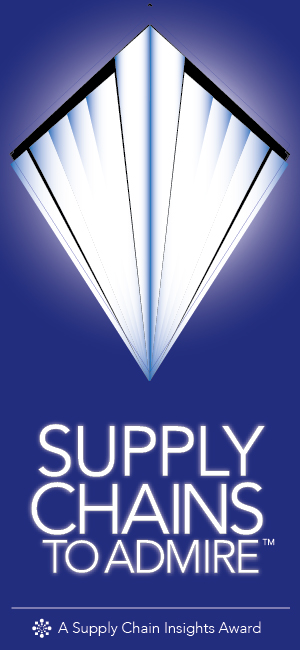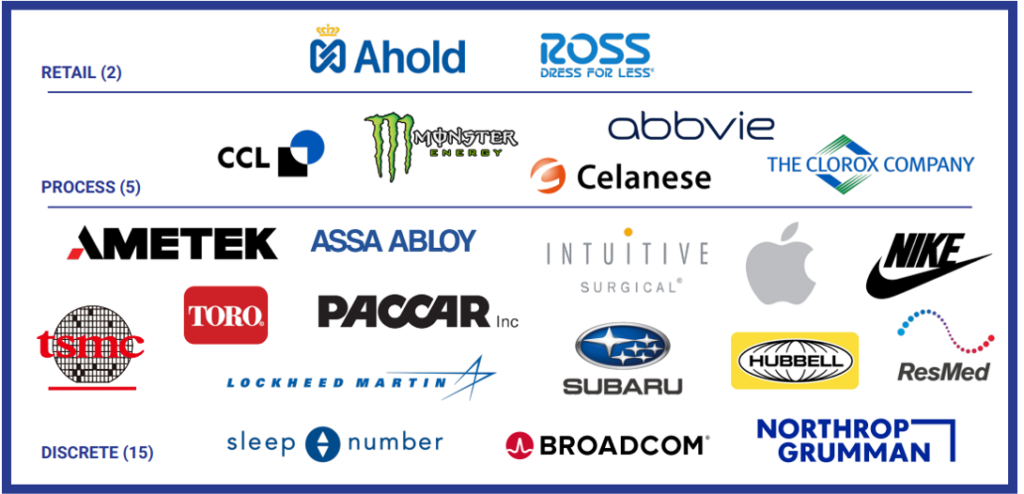In business conversations, the term supply chain excellence rolls off the tongue frequently in meetings, but what does it mean? My insight? There is no standard answer. Excellence is actively sought but seldom defined for business teams. Most teams are on a journey without a clear compass.

Supply chain excellence is harder to define than to say. To help, we analyze business results each year to understand which companies outperform on the balanced scorecard of growth, inventory turns, operating margin, and Return on Invested Capital (ROIC) over the past ten years. We designed the Supply Chains to Admire Methodology to help companies define supply chain excellence.
Why do we spend four months doing this? We aim to move companies from a cost-based agenda to drive value in their supply chains. The selection of metrics is based on prior work with Arizona State University to understand which metrics, in combination, correlate to market capitalization and price to book value.
The report’s goal is threefold: guide supply chain leaders in setting realistic supply chain goals, reward companies that are achieving higher levels of supply chain excellence, and understand what is achievable in executing multi-year roadmaps. We calculate the results based on public data from the period 2012-2021. Five winners from this analysis are speaking at this year’s Supply Chain Insights Global Summit.
In the 2022 analysis, twenty-two companies meet the Supply Chains to Admire Award criteria for Supply Chain improvement, performance, and value. The winners include Apple, AbbVie Inc., Assa Abloy AB, Ametek, Broadcom, CCL Industries, Celanese, Clorox, Intuitive Surgical, Hubble, Lockheed Martin Corporation, Koninklijke Ahold Delhaize NV, Monster Beverages, Nike Inc., Northrup Grumman, PACCAR Inc, ResMed, Ross Stores, Sleep Number, Subaru, Toro, and Taiwan Semiconductor Manufacturing (TSMC) Company. Congrats to all.

What Have I Learned?
This process has many insights, but let me share my top five.
- Industry Bias. When I ask supply chain leaders to name their list of supply chain leaders, it never matches the list of the Supply Chains to Admire. In the industry, there is a bias to place the mantle of supply chain leadership on companies based on company brand perception. The large and well-known companies in the process and retail industries get the nod, but the most significant improvements in supply chain excellence are happening in the discrete industries. Broadcom, Paccar, and TSMC are quiet leaders placing for more than five years in the Winner’s Circle.
- The Greater the Margin, The Slower the Improvement. The large Pharmaceutical companies with a 22% margin and the Medical Device industry with a 20% profit margin are slow to drive improvement. The smaller upstarts with unique business models —AbbVie in Pharmaceuticals and Intuitive Surgical in the Medical Device industry–beat their larger and more established players in the industry sector. For six years in the evolution of the Supply Chains to Admire methodology, there were no winners in these two sectors. The start-ups changed this and put these industry sectors into the leader’s circle. More supply chain innovation happens in contract manufacturing–look at Jabil’s results–in the Contract Manufacturing industry with a 6-8% margin than in these high margin sectors. (No industry leader is attempting to redefine value in the healthcare industries in these value chains despite the margin advantage.)
- Supply Chain Excellence Is Closely Coupled With Product Innovation. Companies with strong product innovation focused on delivering excellence to the customer win. Supply chain excellence happens when the leadership team is driven by product and service innovation with a passionate focus on the customer. Consider the case study of Sleep Number that outperforms in the furniture sector. The company does not sell mattresses; they sell sleep. The focus is on service excellence with white glove delivery to the home. This is the fourth win for Sleep Number.
- Leaders Manage Complexity While Laggards React to Complexity and Let it Define Their Supply Chain. Few companies actively manage complexity and automate segmentation strategies. One of my favorite supply chain leadership stories is Clorox. I smiled as I tabulated the results and saw them rise in the sector to return to the Winner’s Circle for the third time. I love the team’s work on supply chain segmentation and complexity management. They are the only company I know of that trained marketing and sales teams on supply chain constraints and segmentations as it ties to product lifecycle management. (They used the work built together in 2004-2009 to build a course with Georgia Tech for executive training.)
- Smaller Companies Outperform Larger Companies. I struggle to find economies of scale in supply chain performance. M&A degrades balance sheets, and the larger the company, the greater the struggle for organizational alignment. Over the last decade, the gap between financial and operations teams grew in larger companies (greater than 5B$ in annual revenue). Many financial groups equate supply chain excellence to a cost-based agenda, mistakenly believing that saving costs in the back office can fuel growth in commercial teams. A marketing-driven or a sales-driven agenda throws the supply chain out of balance, decreasing margin and reliability. The reason? Many companies mistakenly believe that they are shaping demand when in reality the company is shifting demand, increasing cost and complexity. This lack of alignment increases process latency (time to make a decision) and decreases agility. (I encourage all to do this modeling in simulation to educate executive teams.)
So What?
I believe that the supply chain leader’s goal is to help companies drive value. To accomplish this requires continual education of the executive team and beating down the commonly-held myths of supply chain excellence. Visualization and modeling help drive a more holistic understanding of using the supply chain to drive value and improve reliability. Show the executive team the impact of what I call the top 10 myths in supply chain management:
- The most effective supply chain is the efficient supply chain. The focus needs to be on cost reduction. Reality. Most companies have 5-7 supply chains. The efficient supply chain is usually only a fit for about 40-50% of the volume.
- Focus on the basics (code for transactional efficiency), and the results will follow. Reality. Transactional efficiency is essential but not sufficient. Leaders invest in analytics and customer-centric innovation. Align the organization to a customer-centric business model.
- Functional efficiency drives superior results. Reality. The focus on operational efficiency–both in implementing technology and metrics reward systems–throws the supply chain out of balance, decreasing alignment and increasing the time to make decisions.
- Companies can win with an IT standardization policy. Reality. Companies focused on IT standardization throw the supply chain out of balance by implementing technology for the sake of technology.
- The industry has best practices. Reality. We are living in a period of unprecedented change. We need to learn from the past to unlearn to relearn to think differently. Leaders start by answering the question, “How to design the supply chain to drive unique value for customers?” They then evolve based on business requirements.
The term “supply chain” means different things to different companies. The processes of make, source, and deliver reports to a common leader in only 40% of businesses. Organizations are drowning in data that they cannot use. Unlock your potential by thinking differently. Think outside in and focus on flow optimization across the organizational silos—redesign work to enable better decisions. Unlock the potential of new forms of analytics and educate teams. The work is not easy, but it is essential to outperform a peer group.
In the industry, we have a flywheel of disinformation. There are too many conferences where speakers are assumed to be industry leaders but underperform. Event companies in the industry do the practice a disservice by taking money from technologists and creating superficial narratives to help technologies sell more tech. The answer is not more tech, but we cannot get where we need to go unless we embrace innovation. Leaders should be accountable for balance sheet performance. I hope that the Supply Chains to Admire helps to break through the flywheel of disinformation.
See You At the Supply Chain Insights Global Summit?

Registrations are pouring in for the Supply Chain Insights Global Summit on September 6th-8th in Washington, DC. The focus of the conference is on Supply Chain 2030. This conference has a physical presence for 90-100 business leaders at the Westin near Dulles Airport and a virtual component that Sarah Barnes Humphrey will facilitate on a collaborative platform.
In both formats, we design the conference for extreme networking. We aim to build a guiding coalition of industry leaders to drive change. We need to redefine supply chain planning architectures, but it needs to start with redesigning work. To do this, we must have a different discussion and free ourselves from conventional thinking. Here are five reasons to attend:
- Jump Start Your Learning on the Art of the Possible and New Forms of Analytics. The event is designed for extreme networking. In both the online and in-person format, you will engage with others by learning from case studies of hand-picked speakers, sharing research-based content, fun activities, facilitated networking, and structured activities.
- Imagine Supply Chain 2030. Challenge yourself to imagine the future in an environment where technology innovators and business leaders are equals. The event has no sponsorships and no technologist or consultant sales teams. Instead, it is designed as a learning environment, the event is designed as a place where leaders learn from leaders in a structured and safe environment.
- Supply Chains to Admire. Only 4% of public companies outperformed their peer group over the last decade. At the conference, hear from five Supply Chains to Admire Award winners and brainstorm on lessons learned.
- Learn from the Past to Unlearn. In the last decade, supply chain performance declined. All companies were challenged by the pandemic. In this session, gain insights on how we better align organizations and build outside-in processes.
- Build Teams. The question is how do we drive next-generation talent. Learn from an industry leader case study and a panel of educators.
The virtual event is hosted by Sarah Barnes-Humphrey of Let’s Talk Supply Chain. The online conference is packed full of activities and networking opportunities. The cost for the virtual event is $1500. Sign-up your team now to get the prep materials in the countdown to the event.
The in-person event will be at the Westin at Dulles Airport. Attendees at the in-person event will Imagine Supply Chain 2030 through a series of structured activities with learnings captured by a visual artist. The dreams will take flight in a visit to the Smithsonian Air & Space Museum in a special tour for the group.







